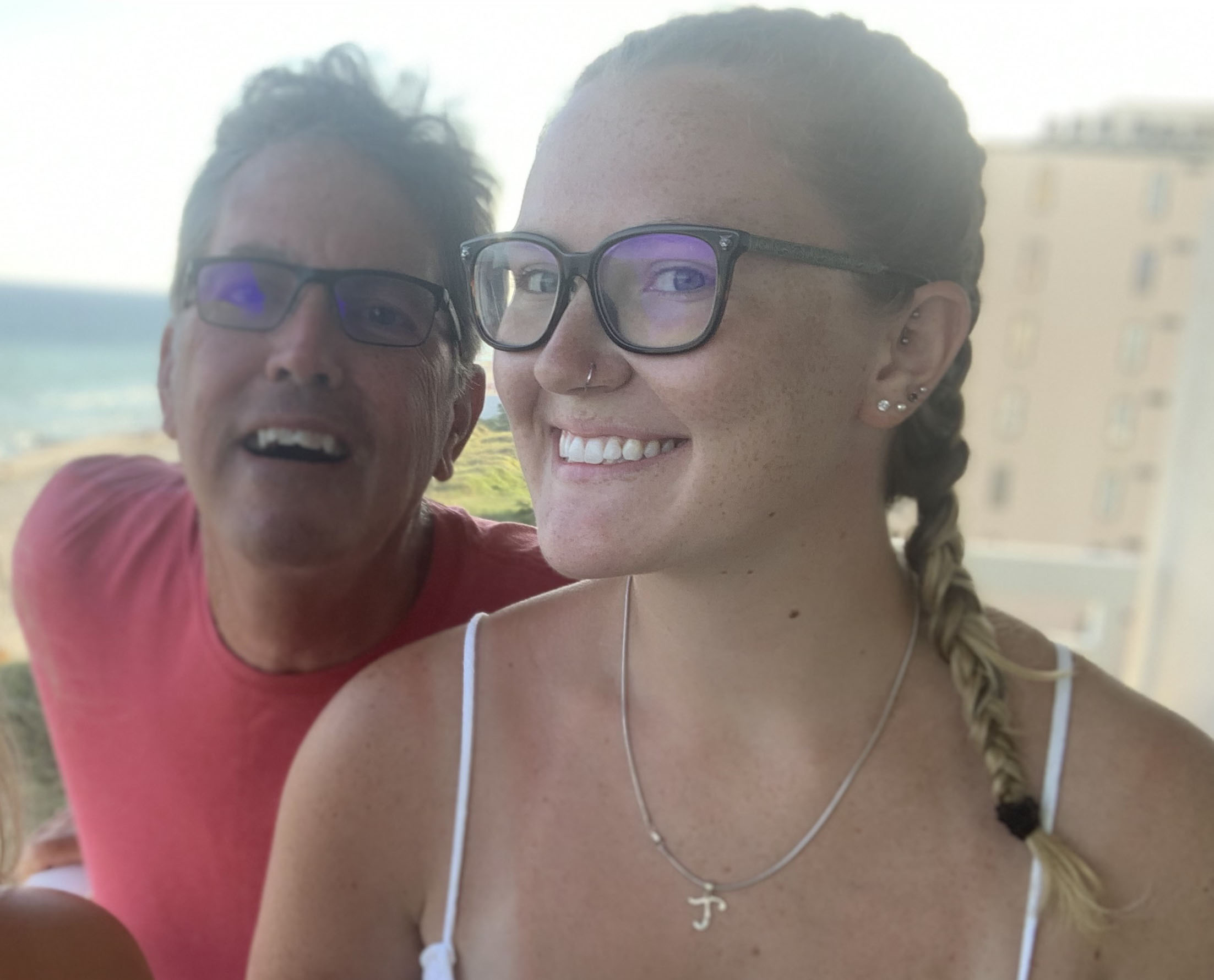The Medicine of Movement
April 23, 2025
LSU Researchers Work with the Parkinson’s Community to Ease Symptoms and Improve Lives
Parkinson’s disease (PD) is the second most common age-related neurodegenerative condition diagnosed in North America, according to the National Institutes of Health.

Taylor Gauss (left) and Jan Hondzinski
– Photos by Katherine Seghers
An estimated one million people are living with Parkinson’s in the United States. While there is no cure, Professor Jan Hondzinski in the LSU School of Kinesiology and Ogden Honors College shares her research with the PD community to help them lessen symptoms—including tremors, stiffness, slow movement, and imbalance—and improve their quality of life.
Hondzinski’s non-medical treatments for those living with Parkinson’s include treadmill walking, rhythmic auditory stimulation, multidirectional step practice, and tai chi.
“Evidence is increasing for not only the ability of aerobic exercise to help limit neural declines that accompany Parkinson’s, but it can also increase oxygen uptake to improve fitness; improve mood, self-esteem, and energy; decrease inflammation and stress; result in relaxation and better sleep; and improve brain connectivity,” said Hondzinski.
— Video by Callie Boyd
A Multigenerational Mission

Grad student Taylor Gauss and her father
Working alongside Hondzinski is graduate assistant Taylor Gauss whose father was diagnosed with Parkinson’s when she was in the eighth grade and passed away in 2023. As an undergraduate at the University of Florida, she would go to Rock Steady Boxing classes with him and eventually began teaching fitness classes for people with Parkinson’s. That’s when a spark took hold.
“I just knew I wanted to help people with Parkinson’s through exercise in some way,” said Gauss. “Then I learned about the neuroscience behind the disease and the rest is history.”
When exploring PhD programs, Gauss learned about Hondzinski’s research and advising style, which brought her to LSU. Together, they are involved in a handful of promising research projects involving people with Parkinson’s, including whether eating wild blueberries can improve movement, whether high-intensity exercise improves symptoms over moderate-intensity exercise, and the effects of muscle-stretching on rigidity and functional performance during standing balance and gait.
From Research to Outreach
Hondzinski came to LSU in 2001. Her initial research in the study of controlling whole-body movements attracted a graduate student who wanted to work with people with Parkinson’s. Through their discussions about the student’s dissertation, they devised the novel protocol of rhythmic auditory stimulation plus multidirectional step training to potentially help the PD population.
“We introduced ourselves to the Parkinson’s community through attending local support groups and brought in a Parkinson’s research specialist to help advise us,” said Hondzinski. “One of the local movement disorder neurologists was impressed with the progress of one of his patients who participated in the study, and thus called me. This led to presentation invitations and slowly developed into funding, research, and community outreach opportunities.”
For more than two decades, Hondzinski has stood on the front lines with the PD community, transforming her research to outreach as often as possible and becoming a leader in her field. She is a co-chair for the annual Louisiana Parkinson’s Conference, speaks at support groups, and participates in community events and groups like Walks for Parkinson’s and Mission for Movement. This engagement extends to students like Gauss, who leads modified tai chi classes on campus for people with balance problems, including those with Parkinson’s.
“I did not have a personal link to Parkinson’s initially. However, through my interactions with people in the community and an interest in helping people with Parkinson’s live better, I currently have several people who have Parkinson’s that I call my friends,” said Hondzinski.
Among those is Karla Louviere who participates in LSU’s modified tai chi classes along with her husband Michael. Mrs. Louviere was diagnosed with Parkinson’s in 2013 after she and her family noticed several symptoms they felt were out of the norm. After her diagnosis, she got to work looking for resources and came across the class, incorporating Hondzinski’s research techniques. She decided to give it a chance and has been a regular participant ever since. Not only has she found it beneficial, but she has found a social group that helps her stay motivated.
“Tai chi helps with stress release, coordination, balance—it’s just a good overall exercise that helps keep my symptoms abated,” said Mrs. Louviere. “It doesn’t solve everything all the time, but overall, it’s been beneficial and helps me with my balance and gets me out of the chair. I want to keep getting out of the chair, and keep getting out of the bed, and keep my inner core balance straight.”
“When she’s had a good day at tai chi, you can tell for the rest of the day: she’s more relaxed, less tense, and easier going,” added Mr. Louviere.










Community and Connection
Consistency and tenacity are important traits for those who have Parkinson’s, as well as those supporting them. It’s also important to seek community support whenever possible. Mr. and Mrs. Louviere are ideal models of those values, with both being committed to combating the disease to the best of their ability. Mr. Louviere volunteers with local Parkinson’s support organizations and is always trying to learn and do more to support his wife.
“The biggest thing is try to be empathetic and try to understand. It’s really hard,” said Mr. Louviere. “Sometimes, it’s just a few words that make it a little easier, but it’s not easy, it’s very difficult because every day is not the same. Every Parkinson’s patient is different, and she’s different every day. There are some great days, and there are some bad days. On the great days, I don’t have to do anything. In fact, I just have to get out of her way. But on the bad days, she needs more support and more patience.”
Gauss underscores the value of connection not only for those with Parkinson’s but for researchers as well.
“I’m hoping to contribute better treatments for Parkinson’s and provide another tool they can use to better their lives.”
— Taylor Gauss
“When you do longer studies with multiple visits and phone calls, you really develop a relationship with the individuals and get to know their lives with Parkinson’s, since Parkinson’s is so different in everyone. It’s those relationships that really make my day and motivate me to help in any way I can,” said Gauss. “I’m hoping to contribute better treatments for Parkinson’s and provide another tool they can use to better their lives.”
As research continues to evolve, Hondzinski finds inspiration in those who battle Parkinson’s each day.
“Think about somebody who has to deal with all of these motor symptoms that can make it difficult for them to move around during the day, it can make it difficult for them to feed themselves, it can make it difficult for them to dress, yet they come out with a positive attitude,” said Hondzinski. “They know that if they go exercise, it’s going to be good for them, so they’re motivated to do that. They’re motivated to help others with the disorder. Some of these people are coming in to do our research to help people in the future; it may not even be helping them right now. The human spirit I see through this group is amazing.”
Today’s research could be tomorrow’s cure. In the meantime, the PD community is hopeful and vigilant.
“Like everyone, people with PD have good days and bad days. It’s challenging to see people have their bad days because then they’ll get discouraged, even though overall they’re doing well. You just have to remind them and yourself that,” said Gauss. “Just because you have Parkinson’s, doesn’t mean it has you.”
If you or a loved one are interested in participating in a Parkinson’s study with Dr. Hondzinski, contact her at jhondz1@lsu.edu or leave a message at 225-578-1016. Each study has participation criteria. For example, those interested in the exercise intensity study have many inclusion and exclusion criteria, including a diagnosis of Parkinson’s within the last three years, not using Parkinson’s medication, and an age range of 40–80.
Next Step
LSU's Scholarship First Agenda is helping achieve health, prosperity, and security for Louisiana and the world.


